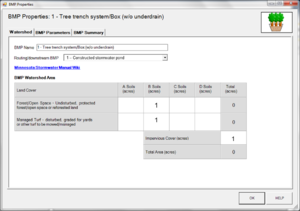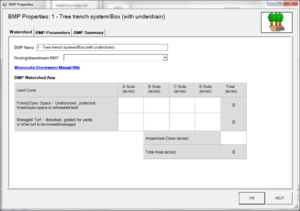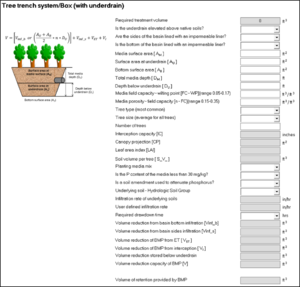
Requirements, recommendations and information for using trees with an underdrain as a BMP in the MIDS calculator
The anticipated construction period for this page is through June, 2014
For a tree trench system/box with an underdrain at the bottom, most of the stormwater captured by the BMP is lost to the underdrain. However, some stormwater infiltrates through the basin bottom and sidewalls if these do not have an impermeable liner. Evapotranspiration (ET) and interception also occur from the trees planted in the system. For a tree trench/box system with an elevated underdrain, in addition to volume losses through the sidewalls and through evapotranspiration and interception, a portion of the water stored in the media between the underdrain and the native soils is infiltrated. In a tree trench/box BMP with an underdrain, all pollutants in infiltrated water are removed, while pollutants are removed through filtration for the water that flows through an underdrain. All pollutants in water lost to ET and interception are removed.
The user should be aware of the difference between a tree trench system and a tree box.
- Tree trench system is a BMP that includes multiple trees. This BMP is commonly used in areas where pavement overlies the trench system. Runoff from the impermeable surface or through a permeable pavement surface is delivered underground to the underlying media in which the trees are planted. This Manual includes case studies and a discussion of types of tree BMPs.
- Tree box (also called soil box) typically includes a single tree. They are typically proprietary products or are included in bioretention BMPs. If a tree is included in a bioretention BMP, we recommend using the bioretention BMP in the MIDS calculator instead of this BMP.
MIDS calculator user inputs for Tree trench system/box
For Tree trench system/tree box with an underdrain BMPs, the user must input the following parameters to calculate the volume and pollutant load reductions associated with the BMP.
- Watershed tab
- BMP Name: this cell is auto-filled but can be changed by the user.
- Routing/downstream BMP: if this BMP is part of a treatment train and water is being routed from this BMP to another BMP, the user selects the name of the BMP from the dropdown box to which water is being routed. All water must be routed to a single downstream BMP. Note that the user must include the BMP receiving the routed water in the Schematic or the BMP will not appear in the dropdown box.
- BMP Watershed Area: BMP watershed areas are the areas draining directly to the BMP. Values can be added for four soil types (Hydrologic Soil Groups (HSG) A, B, C, D) and for three Land Cover types (Forest/Open Space, Managed Turf and impervious). The surface area of the BMP should be included as a managed turf land cover under the hydrologic soils group of the native soils located under the BMP. Units are in acres.
- BMP Parameters tab
- Is the underdrain elevated above native soils?: This is a YES/NO question. Answering YES means the underdrain is elevated within the media. This creates storage capacity between the underdrain and the native soils. Answering NO means that the underdrain is not elevated within the media and is directly above the native soils with no storage capacity below the underdrain.
- Are the sides of the basin lined with an impermeable liner?: This is a YES/NO question. Answering YES means the sides of the basin are lined, preventing water from infiltrating into the native soils. Answering NO means the sides are not lined and infiltration is allowed through the side of the basin into the native soils.
- Is the bottom of the basin lined with an impermeable liner?: This is a YES/NO question. Answering YES means the bottom of the basin is lined, preventing water from infiltrating into the native soils. Answering NO means the bottom is not lined and infiltration is allowed through the bottom of the basin into the native soils.
- Media surface area (AM): This is the surface area at the surface of the engineered media. The user inputs this value in square feet. For a tree trench system this is the cumulative area for all similar trees in the system. Similar trees are trees of the same type (deciduous or coniferous) and size (large, medium, or small tree). See Plant lists for trees for more information.
- Surface area at underdrain (AU): This is the surface area of the BMP at the invert elevation of the underdrain. If the response to “Is the underdrain elevated above native soils?” is set to “No” then this cell will become inactive and populated with the “Bottom surface area” value. The user inputs this value in square feet.
- Bottom surface area (AB): This is the surface area at the bottom of the media within the BMP. Therefore, this is the area at the surface of the underlying soil. The user inputs this value in square feet. For a tree trench system this is the cumulative area for all similar trees in the system. Similar trees are trees of the same type (deciduous or coniferous) and size (large, medium, or small tree). See Plant lists for trees for more information.
- Media depth (DM): This is the media depth between the media surface and the native soils (i.e. thickness of the engineered media). Units are in feet.
- Depth below underdrain (DU): This is the depth of the media between the underdrain invert and the native soils. If the response to “Is the underdrain elevated above native soils?” is set to NO, then this cell will become inactive and populated with a 0. The user inputs this value in feet.
- Media field capacity minus wilting point (FC - WP) - This is the amount of water between field capacity and the permanent wilting point stored in the media. This is water often considered to be available for uptake by plants. If multiple types of media are used in the BMP, this value should be an average of the media installed above the underdrain. Values for field capacity and wilting point based on soil type can be found here. The user inputs this value in cubic feet of water per cubic feet of media.
- Media porosity minus filed capacity (n - FC) - This is the amount of water stored in the media between media porosity (soil saturation) and field capacity. This is the amount of water that is stored in the media and infiltrated into the underlying soils. If multiple types of media are used in the BMP, this value should be an average of the media installed. Values for porosity and field capacity based on soil type can be found here. The user inputs this value in cubic feet of pore space per cubic feet of media.
- Tree Type: The user selects the type of tree planted in the tree trench/box from a drop down menu. The user can select a tree type of deciduous or coniferous. If both deciduous and coniferous trees are planted at the site, they should be treated as separate Tree trench system/tree box BMPs.
- Tree Size: The user selects the size of tree planted in the tree trench/box system. The user can select small, medium or large. Tree size for different tree types are listed in the tree species list. If multiple tree sizes are planted at the site, they should be treated as separate Tree trench system/tree box BMPs.
- Number of trees: The user enters the total number of trees planted in the tree trench/tree box system.
- Planting media mix: The user selects the type of media mix installed for planting from a predefined list of Media mixes: Media mix A (water quality blend), Media mix B (enhanced filtration blend), Media mix C (North Carolina State University water quality blend), Media mix D (tree mix), or Other. This value is used to determine the annual phosphorus load reduction credit.
- Is the P content of the media less than 30 mg/kg?: This is a YES/NO question. The P content of the planting media should be tested using the Mehlich 3 test or an acceptable alternative method. Select YES if the P content of the planting media is less than 30 milligrams per kilogram and NO if it is greater. P content testing is not needed for planting media C or D; therefore, this item will automatically populate to YES if one of those two media types are selected. This value is used to determine the annual phosphorus load reduction credit.
- Is a soil amendment used to attenuate phosphorus?: This is a YES/NO question. Answer YES if the filter media contains soils amendments to enhance phosphorus sorption and NO if amendments are not used. This value is used to determine the annual phosphorus load reduction credit.
- Underlying soil - Hydrologic Soil Group: The user selects the most restrictive soil (lowest hydraulic conductivity) within 3 feet of the soil/media interface in the tree trench/box. There are 14 soil options that fall into 4 different Hydrologic Soil Groups (Hydrologic Soil Group (HSG) A, B, C, or D) for the user. These correspond with soils and infiltration rates contained in this Manual. Once a soil type is selected, the corresponding infiltration rate will populate in the “Infiltration rate of underlying soils” field. The user may also select “User Defined.” This selection will activate the “User Defined Infiltration Rate” cell allowing the user to enter a different value from the values in the predefined selection list. The maximum allowable infiltration rate is 1.63 inches per hour.
- Required drawdown time (hrs): This is the time in which the stormwater captured by the BMP must drain into the underlying soil/media. The user may select from predefined values of 48 or 24 hours. The MPCA Construction Stormwater General Permit requires drawdown within 48 hours, but 24 hours is Highly Recommended when discharges are to a trout stream. The calculator uses the underlying soil infiltration rate and the media depth times porosity to check if the BMP is meeting the drawdown time requirement. The user will encounter an error and be required to enter a new “Media depth” if the stormwater stored in the BMP cannot drawdown in the required time.
- BMP Summary Tab: The BMP Summary tab summarizes the volume and pollutant reductions provided by the specific BMP. It details the performance goal volume reductions and annual average volume, dissolved P, particulate P, and TSS load reductions. Included in the summary are the total volume and pollutant loads received by the BMP from its direct watershed, from upstream BMPs and a combined value of the two. Also included in the summary, are the volume and pollutant load reductions provided by the BMP, in addition to the volume and pollutant loads that exit the BMP through the outflow. This outflow load and volume is what is routed to the downstream BMP if one is defined in the Watershed tab. Finally, percent reductions are provided for the percent of the performance goal achieved, percent annual runoff volume retained, total percent annual particulate phosphorus reduction, total percent annual dissolved phosphorus reduction, total percent annual TP reduction, and total percent annual TSS reduction.



